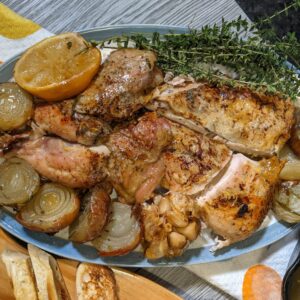
Perfectly Roasted Chicken Dinner
This recipe hits all the marks for a family favourite! It's super easy to make and satisfies almost all the senses! Spatchcocking, better known as butterflying, ensures a juicy chicken with easy-to- serve portions. This method of preparation, reserved for many types of poultry, involves removing the backbone from tail to neck. With the chicken now laying flat, the cooking times are reduced.... another bonus!
Prep Time 15 minutes mins
Cook Time 45 minutes mins
Total Time 1 hour hr
Cuisine American, Italian
Servings 6 servings
Equipment
- cast iron pan
Ingredients
- 5 shallots
- 1 lemon washed
- 1 head of garlic
- 3 tsp kosher salt divided
- 1 tsp ground black pepper
- 1 tsp dried oregano
- 1 4-5 pound whole chicken
- 3 tbsp extra virgin olive oil or unsalted butter
- 2 - 3 sprigs of fresh herbs thyme, rosemary, parsley
- 4 yellow-fleshed potatoes peeled and cut into 1-inch pieces and drizzled with a tbsp of olive oil (optional)
Instructions
Prepare the vegetables and seasoning:
- Peel the shallots and cut in half, horizontally. Set aside.
- Cut the lemon in half, horizontally. Set aside.
- Wash the head of garlic and remove 1 or 2 layers of papery skin. Cut off any roots that are still attached. Slice off the tip of the head to expose the cloves and discard tips. Set aside.
- Mix the salt, black pepper, and oregano in a small bowl. Set aside.
- Preheat oven to 425°F.
Spatchcock the chicken:
- Preheat a 12-inch cast-iron skillet on a low rack in the oven while you prepare the chicken. You may wish to preheat the cast iron pan on the stove.
- Rinse the chicken with cold water. Remove any neck parts and gizzards and discard (see tips below). Use paper towels to pat dry both the skin and the inside cavity.

- Place the chicken on a cutting board, breast-side down, tail closest to you. Use strong poultry shears, cut off the tail tip and discard. Cut along the side of the backbone from the tail to the neck. Do the same on the other side. Remove the backbone (see tips below).
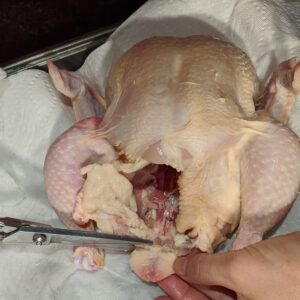
- Turn chicken over so that the breast side is facing up. With the palms of your hands, press down on the breastbone (the bone that forms a “V” at the opposite end of the tail) to crack it. You can also use kitchen shears to cut the breastbone on both sides if you are having trouble applying enough pressure to crack it with your palms. Then cut the remaining breast bone down the middle.
- Use the kitchen shears to snip off the wing tips and discard (see tips below).
- Use your hands to dislocate the leg joints at the hip and knees. Break the joints at the wings. The chicken should be very floppy.

- Be sure to properly clean your cutting board after this process in order to avoid cross-contamination that could lead to foodborne illnesses.
Preparing the pan:
- Before you season the chicken, use your fingers to gently detach the skin from the flesh. Do this for the breasts, thighs and legs, trying not to poke a hole through the skin. You may need to pull back the skin over the thigh and leg to expose the flesh. Sprinkle the salt mixture directly over all the flesh, inside the cavity, and over the skin. Cover the flesh with the skin. Should the skin tear, just try to cover it up with the remaining skin.
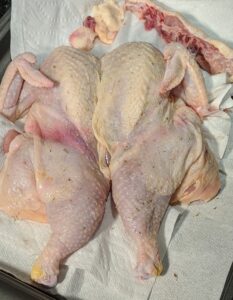
- Remove the pan from the oven and place on a trivet. Be careful as the pan is very hot. Carefully drizzle a tbsp of oil on the pan. Be careful that it doesn’t splatter. Arrange the vegetables (except potatoes) and herbs on the pan, making a bed for the chicken. Lay the flattened chicken on top, breast side up. If using the potatoes, arrange them around the chicken. Drizzle another tbsp of oil on top of the chicken and rub on the skin. Drizzle a tbsp of oil on the garlic to fill in the crevices.
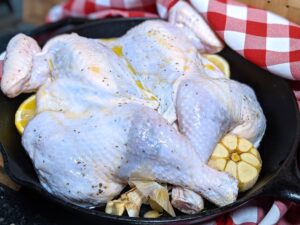
Roasting the chicken:
- Place the pan in the oven and roast until the chicken is golden brown and an instant-read thermometer inserted into the meaty part of the thigh reads 160 to 165 degrees. This could take about 40 minutes. If the chicken browns too quickly, you can lightly cover it with a piece of foil.
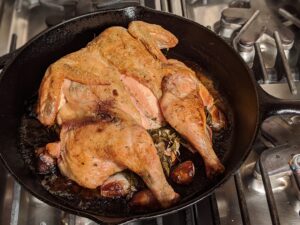
- Remove the pan from the oven and carefully tip the pan to let the cavity juices flow into the pan.
Serving the chicken:
- Let the chicken sit for 10 minutes, covered. Serve right from the pan, exposing the roasted garlic, shallots, and lemon. Discard herbs. Or, using a large spatula, lift the chicken to a platter and arrange the vegetables around it. Spoon pan juices on chicken. Serve.
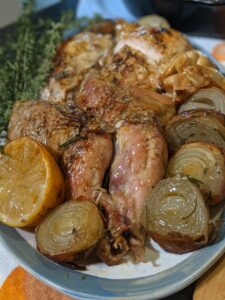
Notes
Tips:
1. Use the discarded chicken parts like the backbone and wing tips to make chicken stock. You must discard the tail tip. Freeze the chicken bones/parts until you have accumulated about 4 to 5 pounds (about 2kg). Then, in a large stock pot, add the chicken bones/parts and cover with about 6 quarts (about 5.5 litres) of cold tap water. Bring to a boil and skim off the foamy scum with a large spoon or small sieve. Reduce to a low simmer and add the aromatics (1 large celery rib with leafy top, 1 large unpeeled and clean onion, 1 carrot unpeeled, 1 bunch parsley, 2 bay leaves, a few peppercorns). Keep the lid slightly ajar and simmer for about 3 hours. I lightly salt the stock. The stock should be flavourful and fragrant. Let cool on the stove and then strain and discard the bones and aromatics. Once completely cooled, place in the fridge. The fat will solidify on the surface, making it easy to remove with a spoon. Label freezer bags, then portion the stock and store in the freezer for your next recipe. 2. If you do not have a cast iron pan, you can use a roasting pan. To heat up the pan, place a tbsp of oil in the pan and heat lightly on the stove. Then remove from the heat and continue with the recipe or simply add the chicken and vegetables to a cold roasting pan.
1. Use the discarded chicken parts like the backbone and wing tips to make chicken stock. You must discard the tail tip. Freeze the chicken bones/parts until you have accumulated about 4 to 5 pounds (about 2kg). Then, in a large stock pot, add the chicken bones/parts and cover with about 6 quarts (about 5.5 litres) of cold tap water. Bring to a boil and skim off the foamy scum with a large spoon or small sieve. Reduce to a low simmer and add the aromatics (1 large celery rib with leafy top, 1 large unpeeled and clean onion, 1 carrot unpeeled, 1 bunch parsley, 2 bay leaves, a few peppercorns). Keep the lid slightly ajar and simmer for about 3 hours. I lightly salt the stock. The stock should be flavourful and fragrant. Let cool on the stove and then strain and discard the bones and aromatics. Once completely cooled, place in the fridge. The fat will solidify on the surface, making it easy to remove with a spoon. Label freezer bags, then portion the stock and store in the freezer for your next recipe. 2. If you do not have a cast iron pan, you can use a roasting pan. To heat up the pan, place a tbsp of oil in the pan and heat lightly on the stove. Then remove from the heat and continue with the recipe or simply add the chicken and vegetables to a cold roasting pan.
Keyword chicken, garlic, lemon, shallots